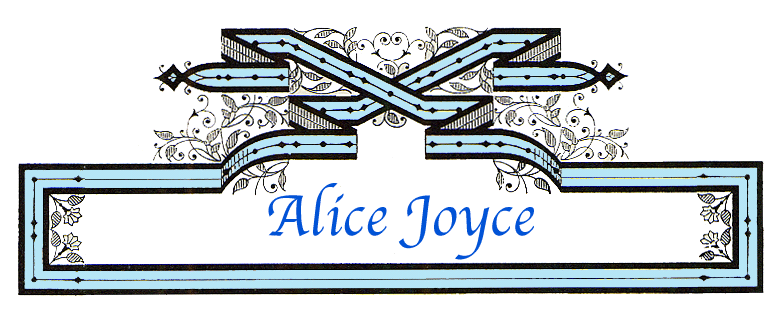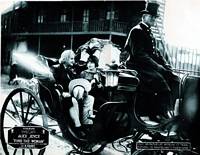

Find the Woman (1918) Vitagraph Co. of America. A Blue Ribbon Feature. Distributor: Greater Vitagraph. Presenter: Albert E. Smith. Director: Tom Terriss. Scenario: Stanley Olmstead. Camera: Joe Shelderfer. Cast: Alice Joyce, Walter McGrail, Henry Houry, Jessie Stevens, Jean Paige, Arthur Donaldson, Martin Faust Victor A. Stewart. 5 reels This film appears to be LOST
| A lobby card from the film with Joyca and Arthur Donaldson. (Thanks to Derek Boothroyd for this picture) Click on thumbnail for larger view |
 |
| Madeline Renard | Alice Joyce |
| Maurice Dumars | Walter McGrail |
| Robbins | Henry Houry |
| Mme. Tibault | Jessie Stevens |
| Ninette | Jean Paige |
| Monsieur Morin | Arthur Donaldson |
| Pierre | Martin Faust |
One of O. Henry's stories, screened by Vitagraph, as a Blue Ribbon Feature, "Find the Woman" has an appeal, and one's interest never lags throughout the five reels. It is an interesting and quaint story told in the author's inimitable style, much of which has been conveyed to the screen.
The scenes are laid in the old French Quarter of New Orleans. The photography is sharp, in fact the whole picture runs with a pleasing smoothness, much of which is due to the careful direction of Tom Terris.
Madeline Renard (Alice Joyce), a gifted member of the French Opera Co., is much beloved by Maurice Dumars, critic on the leading French journal of New Orleans, "L'Abeille" (The Bee). Chance gives her the opportunity to sing Marguerite in Faust," and for the great jewel aria she goes to Monsieur Morin, a pious old man and a marvelous gold worker, and induces him to make a set of paste jewels, Replica of a pearl necklace which had belonged to her mother and of whose existence none of her friends knew.
The old man makes the string of pearls, and the following day is found dead. It appears he had recently become custodian of $20,000 to invest for Madame Tibault, an innkeeper, and her young ward, both friends of Madeline. The $20,000 is not among M. Morin's effects, only a note to Madeline assuring her that he had done her a favor, he would not have done for anyone else, to make paste jewelry.
The disappearance of the gold, the note and the sudden possession by Madeline of her wonderful pearls, all are grievously misconstrued and she, knowing nothing of the suspicions, remains silent.
Complications arise and Madeline, although becoming an opera star, almost loses her sweetheart and at first is despised by her friends. But things are straightened out and everything ends happily.
It is an interesting story, well put together and should be a good program release.
June 15, 1918
"Find the Woman"THE PICTURE
Five-Part Drama by O. Henry. Released by Vitagraph. Features Alice Joyce, supported by Walter McGrail, Jessie Stevens, Jean Paige and Arthur Donaldson. Directed by Tom Terriss.
Values
| Entertainment | Good |
| Story | Good |
| Acting | Good |
| Photography | Good |
| Technical Handling | Good |
| Settings | Good |
| Moral Effect | Wholesome |
Points of Interest
The picturization of "O. Henry's short story, "Cherchez la Femme." The atmosphere found in the original work transferred to the screen with fidelity, with the interesting old streets, cafes, and houses of New Orleans making a picturesque background. Alice Joyce's sincere and effective acting in the role of a beautiful opera star.
Story and Production
"Find the Woman" has much of the charm, the atmosphere and skillful characterization that was found in "Cherchez la Femme"--one of O. Henry's most popular short stories. To the fine part of Madeline Renard Alice Joyce brought all her skill and artistry. She looked unusually lovely and made a striking picture in the old gardens and crooked streets of the southern city. She was given excellent support, and Tom Terriss, in directing the picture, deserves commendations for having preserved the one of the O. Henry tale.
While the story did not move rapidly in the opening reel, it progressed evenly once the different characters were introduced in their relationship to one another. Madeline Renard of the story is a talented singer who has won the admiration of New Orleans society and the love of Maurice Dumars, a local critic. She is about to make her debut as Marguerite in "Faust" and goes to Morin, a pious old gentleman and a gold worker of exquisite skill, to make her a set of paste jewels to be worn for this role. This the old man does for her sake, but he is taken suddenly ill and dies immediately after. As he was the custodian of the fortune of Madeline's maid, and the money cannot be found in his rooms, the town soon believes that the jewels bestowed upon Madeline were bought by the money Morin was guarding.
Madeline is unconscious of this suspicion and cannot understand the coolness of her friends and sweetheart. But one day the little maid's fortune is found and for the first time Madeline learns the truth. She is deeply hurt at Dumar's lack of faith in her, but forgives him and once again she is the adored one of Dumars and New Orleans.
ADVERTISING IDEAS
In all advertising be sure to say that "Find the Woman" is a screen version of O. Henry's "Cherchez la Femme." Display photographs of Alice Joyce extensively, as she is very popular. This is not the first O. Henry picture that Vitagraph has presented, and in general they are certain to meet with success. Seek the co-operation of the local book stores. Have them display the works of O. Henry in their windows with a sign which states that "Alice Joyce Will Be Seen in a Screen Version of an O. Henry Story, 'Cherchez la Femme,' at the ------ Theater on --------." The combination of O. Henry and Alice Joyce should prove a sufficient drawing card without resorting to "stunt" advertising. Make use of the Vitagraph paper prepared for the film.
Catch Phrases
"Find the Woman and You Will Usually Find the Reason for a Man's Misery." "The Woman Wrongly Accused in 'Find the Woman' Was Guiltless. See If She Misjudged Her Accusers When She Was Finally Vindicated." "If You See 'Find the Woman' You Will See a Charming Romance of Old New Orleans."
June 29, 1918
"Find the Woman"WIRE REPORTS--EAST
| Box Office Value | Fair |
Exhibitor Comments: "Too many impossible situations." "Nice little picture."
WIRE REPORTS--WEST
| Box Office Value | Good |
Exhibitor Comments: "Alice Joyce always popular." "Story slow in getting started." "Used Joyce name prominently in newspaper advertising."
BOARD OF REVIEW REPORT
| Entertainment | Good |
| Story | Good |
| Acting | Good |
| Photography | Good |
| Technical Handling | Good |
| Settings | Good |
| Moral Effect | Wholesome |
THE PICTURE
Five-Part Drama by O. Henry. Released by Vitagraph. Features Alice Joyce, supported by Walter McGrail, Jessie Stevens, Jean Paige and Arthur Donaldson. Directed by Tom Terriss.
Synopsis of Story.
The heroine of the story is a talented opera singer, who has won the admiration of New
Orleans society and the love of a young newspaper reporter. For a while they are very happy, but soon disquieting reports about an affair between the girl and an old gold worker disturb the young lover's faith. But in the end the singer's name is cleared, and she, really loving him, forgives him.
"FIND THE WOMAN"
Vitagraph Presents Alice Joyce in a Blue Ribbon Feature by Stanley Olmstead From Suggestions by O. Henry's Cherchez la Femme.
| Madeline Bernard | Alice Joyce |
| Maurice Dumars | Walter McGrail |
| Monsieur Morin | Arthur Donaldson |
| Madame Tibault | Jessie Stevens |
| Nicolette | Jean Paige |
| Sol Robbins | Henry Houry |
| Sister Felicite | Mary K. Carr |
Directed by Tom Terris [sic]
The Story: Maurice Dumars, a journalist, is enamored of Madeline Renard of a French opera company. She is to sing Marguerite in Faust and induces Monsieur Morin, a gold worker, to make a past replica of a string of pearls, which belong to her mother and which is worth $20,000, for the great jewel aria. Morin makes the counterfeit gems, and the next day is found dead. The $20,000 which Mr. Morin received from Madame Thibault to invest for her is missing from his effects but a note from him to Madeline which is found saying he had done her a great favor in making the jewelry casts suspicion upon the opera singer. When she makes her appearance as Marguerite in Faust she is hissed, and she tells of her business relations with M. Morin and of her mother's jewels. Simultaneous with her leaving the convent a year or so later, where she had gone to seek refuge, Dumars finds pinned on the walls of Mme. Tibault's inn the $20,000 in bank notes which M. Morin had given her and which she had carelessly left there . With the mystery cleared, Madeline is again sought by Dumars and all who had done an injustice.
"FIND THE WOMAN"
Vitagraph Version of O. Henry Story Presents Alice Joyce in Pleasing Romance.
Reviewed by Edward Weitzel.
THE gifted author of the O. Henry stories must have been in a very romantic mood when he wrote "Find the Woman," which has been produced on the screen by the Vitagraph Company as a Blue Ribbon Feature. The picture is a love story, with Madeline Renard, of the French Opera Company of New Orleans, as its heroine. Alice Joyce plays the part, and makes it human and appealing. Modern realism has little in common with the method and personality of this refined and earnest actress, the gentleness and charm of the young opera singer who is the central character in "Find the Woman" fits her in every way. Tom Terriss directed the picture. His work is greatly to his credit. The New Orleans exteriors are well chosen and there are glimpses of an old garden that are very beautiful.
Unless one knows New Orleans intimately it is difficult to realize that the scenes of the story are in the United States and the time is today. The entire atmosphere is French, and O. Henry has caught the style of the French romantic school. Mme. Tibault, the keeper of the cafe, who pastes a fortune in Government bonds over a crack in the wall, is a character that belongs to a land different from ours. The fortune was left her by an aunt, and intrusted [sic] to Monsieur Morin, an unworldly old gold worker, who invested in the bonds for madame, and then died without telling her their value. Madaline, who is to sing Marguerite in "Faust," has Morin make her a number of paste jewels to wear in the part. A pearl necklace that belonged to her mother gets mixed with the imitation jewels, and Morin is supposed to have used Madame Tibault's money to pay for the necklace, and given it to the opera singer. Madaline almost loses her lover through the mistake, after she gives up the pearls to shield the old goldsmith's name. The ending is a happy one.
Walter McGrail, Henry Houry, Jessie Stevens, Jean Paige, Arthur Donaldson, and Martin Faust complete the cast.
Last revised October 8, 2005